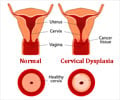A recent model predicted cervical cancer rates are stable or trending down in countries with effective screening measures and similar trends to follow for next 15 years, based on countries’ socioeconomic development.

Cervical cancer is a potentially preventable disease, through screening to detect and treat precancerous lesions and through vaccination against HPV.
To reveal the most recent global patterns and trends of cervical cancer, a team of researchers from the Zhejiang University School of Medicine in China, examined information released by the International Agency for Research on Cancer pertaining to 31 countries.
The researchers found that cervical cancer incidence and mortality rates were lower in more socioeconomically developed countries.
Both past and predicted trends appear to be stable or decreasing in most countries, especially in those with effective cervical cancer screening and HPV vaccination programs.
Over the most recent 10 years, 12 countries had stable cervical cancer incidence rates, 14 had decreasing rates, and five had increasing rates. In terms of mortality from cervical cancer, 12 countries had stable rates, 18 had decreasing rates, and one had an increased rate.
Advertisement
For mortality from cervical cancer, 16 are predicted to have stable rates, 10 to have decreasing rates, and one to have an increasing rate.
Advertisement
Source-Medindia














